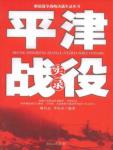Chapter 1 sequence
As we celebrate the 80th anniversary of the birth of the Chinese People's Liberation Army, and today we need to continue to inherit the glorious revolutionary tradition and carry forward the spirit of patriotism and revolutionary heroism, we cannot help but look back at the most representative figures in the People's Liberation War that have contributed to China's historical destiny and future. Strategic battles of decisive significance such as Liaoshen, Huaihai, Pingjin, and crossing the river.
These major battles not only shocked the whole of China and the whole world at that time, but also the shocking war scenes and the heroic spirit of swallowing mountains and rivers are undoubtedly still rare teaching materials and great inspiration for people today. and educational significance.
The brief situation of the Battle of Pingjin is as follows: After the Liaoshen Campaign ended, the Central Military Commission of the Communist Party of China instructed the Northeast Field Army to enter Shanhaiguan secretly, and then joined the North China Field Army and local troops with a total of one million people to launch the Pingjin Battle on November 29, 1948.The Central Committee of the Communist Party of China decided that Lin Biao, Luo Ronghuan, and Nie Rongzhen would form the General Front Committee of the Pingjin Operation, with Lin Biao as the secretary.The Battle of Pingjin was divided into 3 stages.In the first stage, the People's Liberation Army cut off the passage of the Kuomintang army fleeing south and west with swift action, surrounded the Fu Zuoyi Group on the Pingjin and Pingzhang lines, and completed the division of Zhangjiakou, Xinbaoan, Beiping, Tianjin, and Tanggu Task.In the second stage, the People's Liberation Army wiped out Xinbao, Zhangjiakou, and Tianjin defending the enemy, leaving the Kuomintang army in Beiping isolated. On December 22, the Second Corps of the North China Military Region surrounded and annihilated the headquarters of the 35th Army and two divisions of Fu Zuoyi's elite troops stationed in Xinbao. On the 24th, the North China Military Region and the Northeast Field Army, with the cooperation of the Inner Mongolia Military Region, captured Zhangjiakou and wiped out 1 military headquarters, 7 divisions and 2 cavalry brigades belonging to the 11th Corps of the defending enemy. On January 14, 1949, the Northeast Field Army concentrated 340,000 people to launch a general attack on the Tianjin defenders who refused to lay down their arms. On the 15th, more than 130,000 Kuomintang defenders were wiped out, and Tianjin was liberated; on the 17th, Tanggu was liberated by victory.The third stage is the peaceful liberation of Peiping.After many negotiations and the urging of the CCP's underground party organizations and enlightened people, General Fu Zuoyi led 250,000 Beiping defenders to accept the adaptation. On January 31, the People's Liberation Army entered Beiping, and Beiping declared its peaceful liberation.The Battle of Pingjin lasted 64 days. The People's Liberation Army wiped out and reorganized more than 520,000 Kuomintang troops, and North China was basically liberated.
This strategic decisive battle has been going on for nearly 60 years, and people basically know the above-mentioned general situation, but they may not be completely clear about those important details and little-known historical materials.For example: Is Mao Zedong going to deal with Yan Xishan first and then fight Pingjin? Why does Fu Zuoyi stick to Pingjin instead of listening to Chiang Kai-shek? The policy of "separate but not encircle, encircle and not fight", why Lin Biao failed to persuade Chen Changjie to surrender, what factors prompted Fu Zuoyi to walk on the road to peace, what happened to the "Suiyuan Way"...
These details and records may be more meaningful for people to understand the ins and outs of this battle in more detail, to be familiar with the superb wisdom, strategy and command art of our army commander, and to perceive the heroic and tenacious fighting spirit of the People's Liberation Army.Therefore, this book takes the name as its name, selects some viewpoints that people may not be familiar with, and makes a comprehensive and detailed description.
Focusing on explaining the struggle strategies, campaign decisions, and deployment of troops of the Chinese Communist Party and the two parties in this battle, especially some details of how the Kuomintang army failed and how the People's Liberation Army won, is not to describe some internal secrets that cannot be made public.
The narration of history must respect history, and there must be no falsehood or arbitrariness.Although this book adopts the style of documentary literature, it is based on authoritative historical materials, and the plots and facts are well-founded.To this end, we refer to a large number of relevant military history, war history materials and treatises.Here, we would like to express our heartfelt thanks to the authors of these historical materials (attached).

